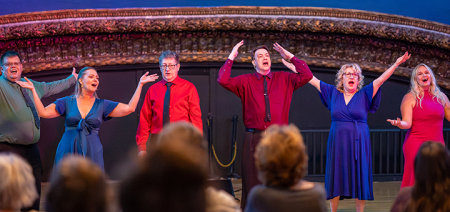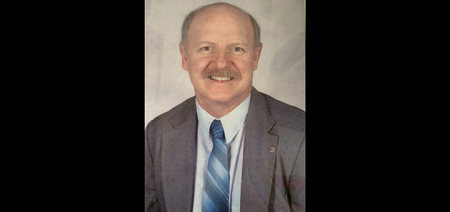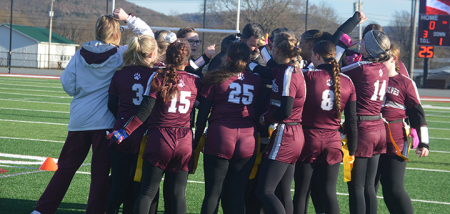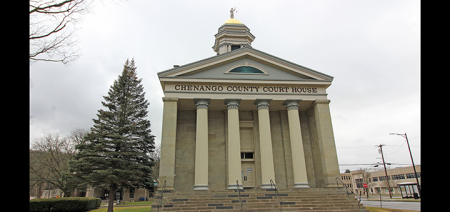Day Of Remembrance: Vets' Home Residents Tell Their Stories
Published:
May 25th, 2009
By:
Melissa Stagnaro

It was truly an honor to visit the New York State Veterans’ Home in Oxford last week. With all of the picnics and barbecues, it is sometimes easy to forget the true meaning of the Memorial Day holiday. I hope that the stories of the veterans I had the privilege of meeting that day will remind you how important it is to remember all of those who have served our country and especially those who have made the ultimate sacrifice so that we as a nation can live free. – MS
The New York State Veterans’ Home in Oxford is home to 242 residents, all of whom are veterans or the spouses or parents of a veteran. Each has a story to tell.
From pin-up girl to military photographer
In the early 1950s, there were less than 2,800 women in the United States Marine Corps. One of them was Sgt. Leah Weatherby.
Originally from Cortland, Weatherby turned 18 during World War II.
“I wanted to join the service then,” she said, but her brother, a paratrooper, wouldn’t hear of it. So, instead, she continued her education and pursued a career in photography.
She even spent some time in front of the camera, becoming something of a pin-up girl for the Crosley automobile. She proudly displays a photograph of herself next to one of these cars as “Miss Crosley.”
When war broke out once more, this time in Korea, Weatherby was working as a photographer at Cornell University. This time, her brother didn’t stand in her way, and in 1951, she joined the Marines.
Weatherby’s first assignment after she completed boot camp at Parris Island was at Henderson Hall in Arlington, Va. There, the Marine Corps put her photographic skills to use taking pictures of VIPs in Washington, D.C. and at Arlington National Cemetery.
She was also asked to take aerial photographs of the nation’s capitol, which she did from a helicopter. There was nothing but a strap across the door to keep her in the aircraft, she explained.
“That took a little getting used to,” she said with a laugh.
She was next transferred to Quantico, where she was responsible for taking ID photos for the Officer Candidate School. This was something of a let down for the vibrant young woman.
“It was so boring,” she said. So much so, that she requested a transfer back to Henderson Hall. That request was granted and Weatherby returned to Arlington.
As she waited for her new marching orders, she was temporarily assigned to the funeral detail at Arlington National Cemetery. While she only spent a week on that detail, the memory has stuck with her. On the first day, she said, there were eleven funerals, all Marines who had been killed in Korea.
In 1953, Weatherby was once again transferred, this time to the Marine Corps Recruit Depot in San Diego. It was there that she met her husband, James Newcomb, who was a musician in the Marine Corps band.
Her hitch was up in 1954, but wasn’t done with the military just yet. She’d spend the next 23 years as a Marine Corps wife. During that time, she and her husband moved around the country, spending time at bases in California, North Carolina, Pennsylvania and Hawaii.
Her favorite was the three years she and her husband spent in Hawaii. “That was heaven,” she said.
Weatherby also looks back fondly on her time as a Marine. She enjoyed the camaraderie of the service. Although there were few women in the military at the time, they were treated well, she said.
“Women marines were respected,” she explained, more than she believes they are now.
A veteran of the “dungaree navy”
Frances Corrigan, known as Mike to his friends, is the first to admit he was a trouble maker in his youth.
“I was in with a bunch of wild guys,” he explained, talking about growing up in Auburn. It was that association which landed him in the United States Navy.
In 1947, when he and his friends landed themselves in more trouble than usual, he was given the option of enlisting or facing prosecution. Until that point, he said, “I hadn’t given the U.S. Navy a moment of thought.”
Boot camp was an eye opening experience for Corrigan. “I thought I was in good shape until I got there,” he recalled.
Everyone was laying odds that he wouldn’t be able to get through even a week of the 13-week basic training, but he quickly learned his street kid attitude wouldn’t cut it in the Navy.
“Once you learned to say ‘yes, sir’ and ‘no, sir,’ they quit bothering you,” he explained.
Corrigan’s first assignment was as a swabbie aboard the USS Sieboey, a carrier he said would be considered small by today’s standards. Still a street kid at heart, it was a little too disciplined and regimented for his taste.
“Your shoes had to be shined; you did all your chores in your dress whites,” he explained. As soon as he got a chance to get off the carrier and into what he called the “Dungaree Navy,” where cut off shorts were more the norm, he jumped at it.
Corrigan soon found himself aboard the USS Gyatt, a destroyer named after a young man from Syracuse; a medal of honor winner who had been killed in action. He served as a torpedoman on the destroyer, which sailed from naval bases up and down the Eastern Seaboard.
While they were called to picket duty to go to the Korean War, and a rescue mission in Greece, they never saw any action. “We were very fortunate,” he said.
But then, he wasn’t surprised that, with all of the naval vessel’s firepower, no one chose to challenge them. “Who’s going to mess with you?” he explained. “These little countries had nothing.”
He separated from the Navy in 1952, with the intention of re-enlisting after a month-long leave. He married instead. His wife was from Norwich and he made his home in upstate New York for the next few decades, working in agriculture and landscaping before relocating to Florida. Now, he’s back in New York and hopes his children and grandchildren will soon move north as well.
As he looks back, at what was a turning point in his life, he is grateful for the opportunity he was given. “Today, I thank those judges, I really do,” he said.
Corrigan has a positive outlook. “The way I look at life is, if you can’t put a little humor in it, what is it all about?” he explained.
He doesn’t dwell on the bad days, he said. “I get moving.”
The humble hero who wrestled with Spartacus and lived to tell the tale
If Thaddeus “Ted” Lewkowicz’s life was made into a movie, his friends speculate that Walter Pidgeon, Jeff Chandler or Jimmy Stewart would have been the ideal candidates to play his part.
Born in Ticonderoga, Lewkowicz is the youngest of four children born Polish immigrants. When he was 9, his parents moved the family to Schenechtedy, which he says at that time was a booming area with a large Polish speaking population.
Lewkowicz was an intelligent young man, and was offered scholarships to both Union College in Schenechtedy and St. Lawrence University. His choice, he said, was made based on which was further from his home.
During his years at St. Lawrence University, he was a classmate of a young man named Isadore Dempsky. The two were on the school’s wrestling team, and while Dempsky was in a lighter weight class, the two were often paired together during practice. This was, of course, a few years before Dempsky changed his name to Kirk Douglas.
Between terms, Lewkowicz traveled to and from the university by train.
“On the train, I felt guilty because there would be young men on the train in uniform and I was not,” he said. That guilt prompted him to sign up for a weather officers training course being conducted by the Air Force at MIT.
“I spent a year there with 150 other fellows,” he said. He graduated from the school in 1941 as a second lieutenant.
As a base weather officer, he said he would receive information on wind velocity and atmospheric pressure via teletype. From this data, “we would make our own weather maps,” he explained.
Lewkowicz felt he could be of valuable to the base if he obtained his pilot’s license, so he applied for flight training. After completing the course in South Carolina, he returned to discover that a “flying weather officer” wasn’t needed.
What they did need, he was told, were bomber pilots. He was then sent to Westover Field, Mass. for training.
“We were developed into a crew,” he explained. “After our training, we were given a new B-24, and sent over to England.” There they joined the 45th Bomb Squadron and commenced bombing runs over Europe.
“If the same situation came up, I’d do the same thing all over again,” Lewkowicz said. “Despite the fact that we were dropping bombs and I suppose a lot of innocent people were killed, I was still opposed to what the Germans were doing.”
Germany was beginning to invade France at this time, he said, expanding their boarders to encompass it and other surrounding countries. “We felt strongly,” he said, “We were strongly motivated, the whole group, and we believed in what we were doing.”
Lewkowicz successfully flew 25 bombing runs without losing a man, and then volunteered for five more. Rather than acknowledge this as extraordinary accomplishment, he simply said, “We were good at following orders.”
He was on a boat headed back to the U.S. on May 8, 1945 when V-E Day was declared.
Despite the fact that he was awarded the Distinguished Flying Cross, (an honor he shares with an elite few including former president George H. W. Bush, Chuck Yeager, John Glenn and Charles Lindbergh) Lewkowicz scoffs at those who call him a hero.
“Each individual part was minuscule compared to the overall effort,” he said.
Author: Melissa Stagnaro - More From This Author
Comments








